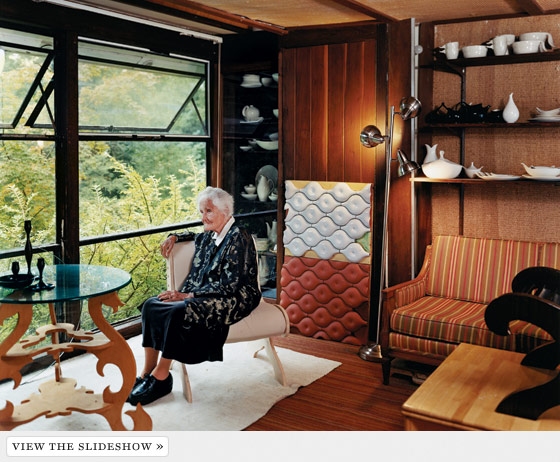
Zeisel photographed recently at her Rockland Country studio, surrounded by her designs: a nineties prototype of a wooden table; the fifties-era bellybutton tiles; and a wall of Hallcraft dishes, originally produced by Royal stafford and now available at Crate & Barrel. Photograph by Mark Heithoff
At 100, Eva Zeisel is not afraid of contradicting herself, especially on the question of timeliness. While she has long held that design represents its current moment, she cannot deny—nor does she want to—her own work’s enormously enduring appeal. Her simple, fluid forms and sensual curves in everything from her tableware to tiles to glassware to furniture to rugs have identified her as one of the most innovative and influential designers of the twentieth century.
Consider Museum White, her porcelain dinner service designed for Castleton China in collaboration with the Museum of Modern Art in 1943. The pieces are still both delicate and voluptuous, tableware where the tactile verges on the erotic. She describes her pieces as “happy to use, happy to handle.”
Born in Budapest in 1906, Zeisel wanted to be a painter and took up pottery only to support that. But by 1924, she was a serious enough designer that she became the first woman in the potter’s guild. Over the next fifteen years, she designed for mass production in Hungary, Germany, and Russia. Arriving in New York in 1938, she embarked on an absurdly prolific period. Her tubular steel and canvas chairs, glassware for Federal Glass, dinner services for Hall China and Castleton, bowls for Nambé, and porcelain vases for KleinReid are only a handful of what she has designed in the nearly 70 years since. She’s still working—a coffee table at Design Within Reach, dinnerware at Royal Stafford, and rugs at the Rug Company are in production.
Though she has lived for decades on the Upper West Side, near Columbia, her design studio is an old, eclectically decorated Rockland County farmhouse. A vast living room accommodates everything from Chinese tapestries to hand-carved Elizabethan furniture to American block-print wallpaper. And in the studio upstairs, her grandparents’ antique silver flatware lies alongside balsa prototypes she is developing.
Tuned in to the emotional attachments people may form with inanimate objects, Zeisel has always opted for expressiveness. Her work is designed, she says, “ to be very friendly.” The patterning for a wool rug has evolved from the repetition of a bellybutton motif; the lip of a porcelain plate has a voluptuous curl; and even at this early stage, a balsa fork has a warm elegance. “It is my way of approaching the world,” Zeisel says. “I am a playful person.”
None of which is to say that design has always been a playful matter. In 1936, working at Dulevo, near Moscow, and recently appointed artistic director of the China and Glass Industry of Russia, she was falsely accused of plotting against Stalin’s life, imprisoned, and put in solitary confinement for sixteen months. “I thought I was going to be shot,” she says. “I kept designing in my mind to stay normal. Not to be crazy. It was a way to survive.”
What she designed, it might be added, was a brassiere. Even under the most extreme circumstances, she never lost the urge to design—or her sense of humor.
Profession: Ceramist
Peak: 1945 to 1965
Essential Design

A 1947 gravy-boat prototype, for United China and Glass. Photograph by Brent C. Brolin